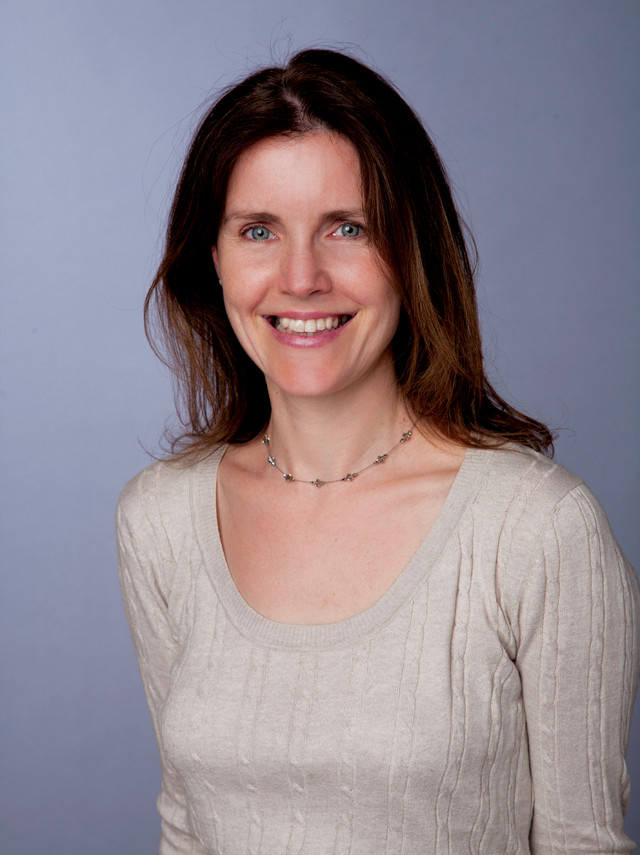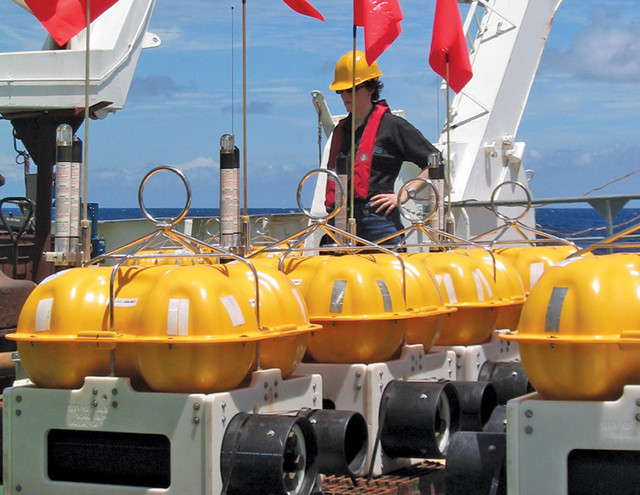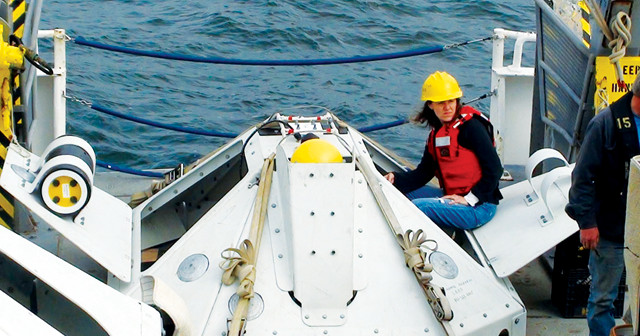
by Sara E. Pratt Friday, May 8, 2015

Marine geophysicist Maya Tolstoy is an associate professor at Columbia University's Lamont-Doherty Earth Observatory. Credit: LDEO.
Growing up in Scotland, Maya Tolstoy was drawn to the theater, and even briefly considered majoring in the subject in college. Instead, she chose to follow another lifelong passion and became a marine geophysicist.
Today, as an associate professor at Columbia University’s Lamont-Doherty Earth Observatory, Tolstoy goes to sea frequently — traveling to such far-flung locales as the Juan de Fuca Ridge and the East Pacific Rise — to learn what earthquakes beneath the ocean can tell us about volcanism, subduction zones and their potential links to climate.
Shortly after receiving her doctorate from Scripps Institution of Oceanography in La Jolla, Calif., Tolstoy discovered some of the first concrete evidence that tides — the shifting of the oceans and solid earth in response to astronomical forces — can trigger earthquakes under the sea. She was also one of the first researchers to observe a volcanic eruption at an ultraslow-spreading center.
Meanwhile, the drama bug has never left her. She appeared in James Cameron’s 2005 3D/IMAX movie, “Aliens of the Deep,” about deep-sea life; she presented a popular TED talk about her research in 2013; and she has even tried her hand at writing a screenplay.
Tolstoy recently spoke with EARTH acting managing editor Sara E. Pratt about how sea level affects volcanism, how shipboard science crews and theater troupes are actually quite similar, and what it was like to try out for NASA’s astronaut corps.
SEP: How did you become interested in science? What or who were your influences growing up?
MT: I was always interested in and exposed to science because my father is a scientist. He got his bachelor’s in geology and then his doctorate in geophysics, but then actually moved more into applied math and underwater acoustics. He also is a great-outdoors person, and many of our family holidays were spent in a tent somewhere in the mountains. So, I was exposed to a lot of science, and geology and geophysics in particular, from a young age, and always had a passion and fascination for it. Both of my sisters are scientists too. One also went into applied math and underwater acoustics. She and my father have actually written papers together. And my other sister is an astronomer.
As far back as I can remember I was fascinated with earthquakes and volcanoes. To realize how tiny you are, and how insignificant, compared to the power in a volcano or an earthquake is awe-inspiring. The thing that really steered me toward what I do now was a summer undergraduate internship at Scripps Institution of Oceanography. I went out to sea for 10 days, and I just fell in love with going to sea. Then I combined that love of going to sea and being on the ocean with the love of volcanoes and earthquakes.

Tolstoy deploying ocean-bottom seismometers. Credit: LDEO.
SEP: You discovered some of the first strong evidence for tidal triggering of earthquakes beneath the deep sea. What is tidal triggering?
MT: Tidal triggering is the notion that earthquakes happen preferentially during peak tidal stresses. It’s not that the earthquakes are being caused by the tides, it’s that earthquakes that will happen anyway start happening slightly more often around the [time of] peak tidal stress than around the [time of] low tidal stress. As a fault becomes critically stressed, it becomes more sensitive to tiny tidal forces. These forces are really small when you compare them with plate tectonic forces. But when a fault system becomes critically stressed … and it’s getting ready to go, the theory is that it then becomes more sensitive to tidal forces.
The reason tidal triggering has been so controversial over the years is that it’s incredibly hard to see [in seismic data], especially on land. In the ocean, it’s not as surprising that you see it, because you have this cyclic loading and unloading of the ocean water [on top of Earth’s crust], whereas on land, tidal triggering is due to the smaller earth-tide effect [in which solid rock in the crust deforms slightly due to tidal forces]. Whether or not tidal triggering occurs wasn’t very clear until we saw it so clearly on the seafloor.
SEP: What are some other projects that you are currently working on?
MT: One new thing that I’m working on is tidal triggering of earthquakes in subduction zone environments. That’s what my TEDx talk was about. A researcher in Japan, Sachiko Tanaka, has published these really interesting results from the Tohoku earthquake [in 2011], the great Sumatra-Andaman earthquake [in 2004] and some others, that show that in about the 10 years preceding one of these very large subduction zone earthquakes, the smaller earthquakes happening in the area of the eventual rupture start showing evidence of tidal triggering. We’re looking, at the moment, in Alaska to see if we see similar signals there — first of all with recent large earthquakes, and then also whether we can see any segments that currently show evidence of tidal triggering and that might tell us about impending earthquakes.
Another project I’m working on, which I’m very excited about, came from my observation that seafloor [volcanic] eruptions are being influenced by the fortnightly modulations of the tide associated with spring and neap tides, which occur when the sun and moon are aligned versus at right angles to each other. Eruptions seem to be happening preferentially in the lows of those fortnightly tides, and they seem to be happening preferentially in the first half of the year when Earth is moving away from the sun.
This started me thinking about how seafloor volcanoes might react to large changes in sea level associated with long-term climate change. I looked at seafloor bathymetry in the southern East Pacific Rise, and saw a pulsing signal of seafloor volcanism on a 100,000-year time period. So, it seems like these long-term climate cycles may also be influencing the volcanism. The obvious question then is if it’s just a one-way thing: Sea level seems to be affecting seafloor volcanism, but does the change in that volcanism feed back into the climate cycle? It’s a pretty complicated story, and it’s not really clear yet how it might feed back into the climate cycle, but it probably does.
SEP: So, when sea level has decreased, volcanism has increased?
MT: Right. When you remove 100 meters of sea level, or whatever the sea-level change is, you’re decreasing the load on the seafloor. [Researchers have] actually seen this in Iceland: When glaciers melted [at the end of the last ice age], there was something like a 20- or 30-fold increase in volcanism. Basically, when the load of the glaciers was off Iceland, there was glacial rebound, and the pressure on the mantle below was removed too, and there was a sudden increase in melting that led to an increase in volcanism. It’s the same effect on the seafloor when you remove seawater from above the mid-ocean ridges.
What I see from the seafloor bathymetry is that the 100,000-year volcanic pulsing signal seems to track carbon dioxide levels in the atmosphere, which also tracks sea level and temperature. What’s really interesting about this is that scientists don’t really understand why the 100,000-year Milankovitch cycle has such a dominant effect on the climate. Well, the 100,000-year cycle basically has to do with eccentricity in Earth’s orbit, and what I’m seeing in the seafloor eruptions is that they’re occurring more often in the first six months of the year, which is also related to orbital eccentricity.

Tolstoy was chief scientist on the 2011 Cascadia Experiment LDEO deployment cruise aboard the R/V Wecoma. Credit: Dean Livelybrooks.
SEP: What was the astronaut interview process like?
MT: Oh, it was awesome. I had so much fun. I made it to the final 47 [out of 3,500 applicants]. The first interview lasted three and a half days down at Johnson Space Center, and the second interview was a full week. At the end of the day, I would have loved to do it, but part of me was also relieved because it’s a very dangerous job that requires a huge amount of travel. My son was very young at the time and I was looking at the possibility of a six-month assignment at the International Space Station as well as many months of training in Russia.
SEP: How did you, as someone who was surrounded by science and nature from a young age, take an interest in the creative arts, and particularly theater?
MT: One thing that I’ve come to realize that I enjoy most about science, and why I really enjoy going to sea as well, is the teamwork aspect of it, which actually links back to my interests in theater and acting. I didn’t realize this until 2009 when I was a finalist for the astronaut program, and I really enjoyed the interview process. The astronaut program appealed to me not just because of the adventure of going into space, but because of the feeling at Johnson Space Center [in Houston, Texas] — it was such a wonderful sort of team atmosphere. Academia tends to be much less team-oriented. I think that’s why I gravitated towards seagoing work; it’s a lot like going into space. It’s about working together in a team in a remote and challenging and sometimes dangerous environment, and making everything work when you don’t have a hardware store down the road. That’s also a big part of my attraction to the acting world — working intensely with a group on a project. In that case, it’s to tell a story, and I like telling stories. Storytelling is a very powerful medium. But it all basically comes down to teamwork. That is really what I enjoy.
SEP: What was it like working with James Cameron on “Aliens of the Deep”?
MT: The Cameron documentary was enormous fun to be involved with, and really interesting, not just scientifically, but because of my background interest in film and acting. It was very cool to be directed by James Cameron. Communicating science to the public is incredibly important and yet largely undervalued. It’s certainly rare that someone of James Cameron’s talent is also so scientifically literate and takes an interest in communicating science. Many films are not scientifically accurate or they portray stereotypes of science. I think that many people who look at science from the outside think of it as almost the opposite of creativity. But being able to think creatively is actually quite important in science.
SEP: Tell me about the screenplay you wrote.
MT: I wrote it with a friend of mine, who was also a seagoing scientist, in 1999 or 2000, when I had a visiting appointment at the University of California, Los Angeles (UCLA). It was his idea, it was set at sea, on a research cruise with a female lead, and he asked for my help. It was about terrorists smuggling in biological weapons using seafloor instruments. You go out there, you recover these instruments, and you bring them back to shore. We do that all the time. Now, in the post-9/11 world, I’m not sure I would even want to write about that. I don’t want to give people ideas.
Anyway, we worked on it for months and it was really fun. We just laughed so much doing it. But it didn’t get produced. It wasn’t good [laughter]. After we finished it, I took a class at UCLA on rewriting your screenplay, and it wasn’t until I took the class that I realized how bad our screenplay was — not bad, bad, but how novice it was. There are all these basic tricks of the trade that you need to know about how to structure things. So I rewrote it, and it got much better, and then my computer was stolen and I didn’t have a back up of the rewritten one.
Once, while we were working on the script, I was eating sushi at a restaurant on Mulholland Drive and the guy next to me started talking to me. He turned out to be a high-up guy at CAA [Creative Artists Agency], Mike Ovitz’s right-hand man. He asked to see the script. So I sent it to him, but this was before it was rewritten. So, I had my big opening, but it was a terrible script at that point. So, I blew it [laughter].
© 2008-2021. All rights reserved. Any copying, redistribution or retransmission of any of the contents of this service without the expressed written permission of the American Geosciences Institute is expressly prohibited. Click here for all copyright requests.